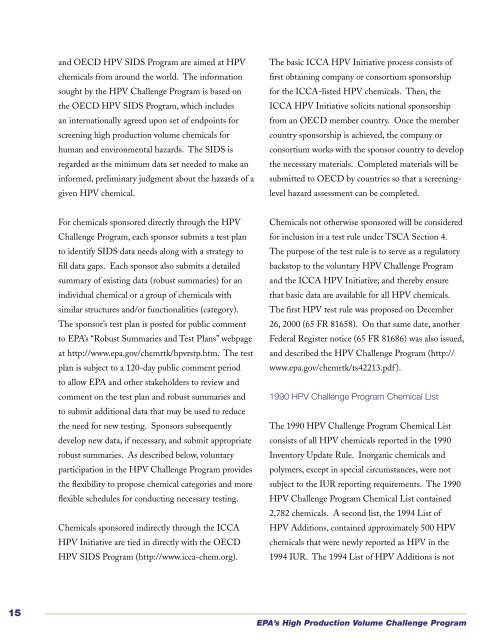Status and Future Directions of the - US Environmental Protection ...
Status and Future Directions of the - US Environmental Protection ...
Status and Future Directions of the - US Environmental Protection ...
You also want an ePaper? Increase the reach of your titles
YUMPU automatically turns print PDFs into web optimized ePapers that Google loves.
15<br />
<strong>and</strong> OECD HPV SIDS Program are aimed at HPV<br />
chemicals from around <strong>the</strong> world. The information<br />
sought by <strong>the</strong> HPV Challenge Program is based on<br />
<strong>the</strong> OECD HPV SIDS Program, which includes<br />
an internationally agreed upon set <strong>of</strong> endpoints for<br />
screening high production volume chemicals for<br />
human <strong>and</strong> environmental hazards. The SIDS is<br />
regarded as <strong>the</strong> minimum data set needed to make an<br />
informed, preliminary judgment about <strong>the</strong> hazards <strong>of</strong> a<br />
given HPV chemical.<br />
For chemicals sponsored directly through <strong>the</strong> HPV<br />
Challenge Program, each sponsor submits a test plan<br />
to identify SIDS data needs along with a strategy to<br />
fill data gaps. Each sponsor also submits a detailed<br />
summary <strong>of</strong> existing data (robust summaries) for an<br />
individual chemical or a group <strong>of</strong> chemicals with<br />
similar structures <strong>and</strong>/or functionalities (category).<br />
The sponsor’s test plan is posted for public comment<br />
to EPA’s “Robust Summaries <strong>and</strong> Test Plans” webpage<br />
at http://www.epa.gov/chemrtk/hpvrstp.htm. The test<br />
plan is subject to a 120-day public comment period<br />
to allow EPA <strong>and</strong> o<strong>the</strong>r stakeholders to review <strong>and</strong><br />
comment on <strong>the</strong> test plan <strong>and</strong> robust summaries <strong>and</strong><br />
to submit additional data that may be used to reduce<br />
<strong>the</strong> need for new testing. Sponsors subsequently<br />
develop new data, if necessary, <strong>and</strong> submit appropriate<br />
robust summaries. As described below, voluntary<br />
participation in <strong>the</strong> HPV Challenge Program provides<br />
<strong>the</strong> flexibility to propose chemical categories <strong>and</strong> more<br />
flexible schedules for conducting necessary testing.<br />
Chemicals sponsored indirectly through <strong>the</strong> ICCA<br />
HPV Initiative are tied in directly with <strong>the</strong> OECD<br />
HPV SIDS Program (http://www.icca-chem.org).<br />
The basic ICCA HPV Initiative process consists <strong>of</strong><br />
first obtaining company or consortium sponsorship<br />
for <strong>the</strong> ICCA-listed HPV chemicals. Then, <strong>the</strong><br />
ICCA HPV Initiative solicits national sponsorship<br />
from an OECD member country. Once <strong>the</strong> member<br />
country sponsorship is achieved, <strong>the</strong> company or<br />
consortium works with <strong>the</strong> sponsor country to develop<br />
<strong>the</strong> necessary materials. Completed materials will be<br />
submitted to OECD by countries so that a screening-<br />
level hazard assessment can be completed.<br />
Chemicals not o<strong>the</strong>rwise sponsored will be considered<br />
for inclusion in a test rule under TSCA Section 4.<br />
The purpose <strong>of</strong> <strong>the</strong> test rule is to serve as a regulatory<br />
backstop to <strong>the</strong> voluntary HPV Challenge Program<br />
<strong>and</strong> <strong>the</strong> ICCA HPV Initiative; <strong>and</strong> <strong>the</strong>reby ensure<br />
that basic data are available for all HPV chemicals.<br />
The first HPV test rule was proposed on December<br />
26, 2000 (65 FR 81658). On that same date, ano<strong>the</strong>r<br />
Federal Register notice (65 FR 81686) was also issued,<br />
<strong>and</strong> described <strong>the</strong> HPV Challenge Program (http://<br />
www.epa.gov/chemrtk/ts42213.pdf ).<br />
1990 HPV Challenge Program Chemical List<br />
The 1990 HPV Challenge Program Chemical List<br />
consists <strong>of</strong> all HPV chemicals reported in <strong>the</strong> 1990<br />
Inventory Update Rule. Inorganic chemicals <strong>and</strong><br />
polymers, except in special circumstances, were not<br />
subject to <strong>the</strong> IUR reporting requirements. The 1990<br />
HPV Challenge Program Chemical List contained<br />
2,782 chemicals. A second list, <strong>the</strong> 1994 List <strong>of</strong><br />
HPV Additions, contained approximately 500 HPV<br />
chemicals that were newly reported as HPV in <strong>the</strong><br />
1994 IUR. The 1994 List <strong>of</strong> HPV Additions is not<br />
EPA’s High Production Volume Challenge Program<br />
a part <strong>of</strong> <strong>the</strong> HPV Challenge Program at this time,<br />
but was provided for use by companies who desired<br />
to propose categories <strong>of</strong> chemicals <strong>and</strong> wished to<br />
include chemicals from <strong>the</strong> 1994 list in <strong>the</strong>ir category<br />
definitions. Additionally, in some cases, companies<br />
or consortia have sponsored chemicals that are not on<br />
ei<strong>the</strong>r <strong>the</strong> 1990 HPV Challenge Program Chemical<br />
List or <strong>the</strong> 1994 List <strong>of</strong> HPV Additions. For <strong>the</strong><br />
purposes <strong>of</strong> this report, <strong>the</strong>se chemicals are included in<br />
<strong>the</strong> number <strong>of</strong> sponsored chemicals, <strong>and</strong> no distinction<br />
is made between <strong>the</strong>se chemicals <strong>and</strong> those chemicals<br />
on <strong>the</strong> 1990 HPV Challenge Program Chemical List<br />
once <strong>the</strong>y are sponsored.<br />
<strong>Status</strong> <strong>and</strong> <strong>Future</strong> <strong>Directions</strong><br />
16

















